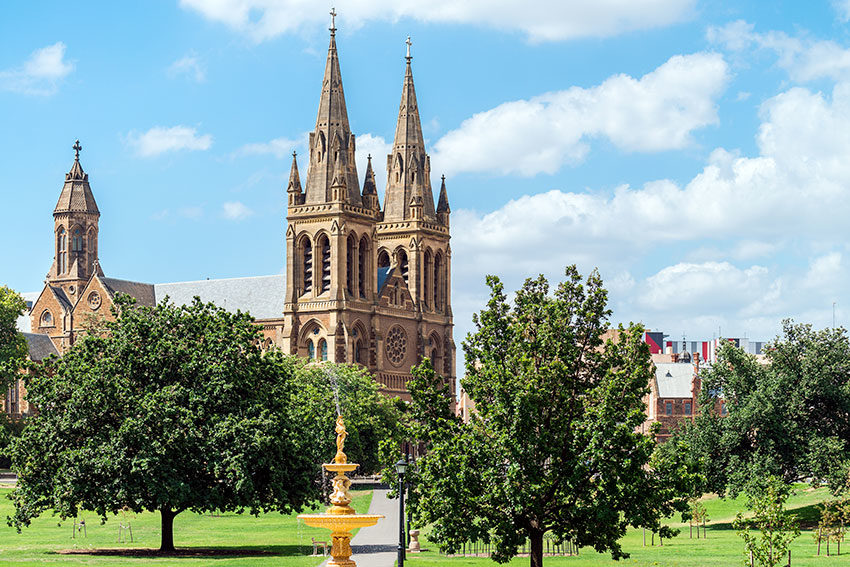An iconic milestone: St Peter’s Cathedral celebrates 150 years

Adelaide’s iconic St Peter’s Cathedral turns 150 in late June and this significant anniversary is being celebrated with a series of events throughout the year: Festival 150.
If you’ve ever been to the cricket on a summer evening and left through the northern gates, you will have seen one of our city’s oldest and best views – the stone towers of St Peter’s Cathedral through the treetops in the dusk. If you’ve timed it well, the bells in those towers might, at that moment, chime. It doesn’t matter if you’re a religious person or not, a city’s temples of faith are often amongst its greatest feats in architecture and so become fixed in a city’s cultural identity.
Inside the cathedral, light filters through many-coloured windows. At the King William Street end, there is the glow of the rose window crafted in the French Gothic tradition, while the rest of the church is flanked by early 20th-century nave windows and the more contemporary clerestory works by local artist Cedar Prest. Parallel to the pulpit, artist David Wright’s 2001 Magdalene Window tells the story of women in the Christian tradition.
For Anglicans, of course, this is a holy place laced with meaning and symbolism. The seat – or in Latin, cathedra – of the Archbishop of Adelaide, it is a house of worship, a community gathering place, a gallery of religious artefacts, art and music, and space for earnest ceremony.
Adelaide was a city still in its infancy when the building’s foundation stone was laid 150 years ago on St Peter’s Day, June 29, 1869. Bishop Augustus Short, the city’s first Anglican Bishop, had been working towards building the cathedral since the day he was consecrated at Westminster Abbey 22 years earlier.

“He was an energetic man,” says the cathedral’s archivist Brian White. “He was a pugilist, a knuckle-duster, a fighter!
“There are stories of him fighting people who caused trouble in the bush or dealing discipline to unruly shearers.”
“He was a great educator and scholar, too,” says Pauline Brooks, who is the convener of Festival 150, a program of events running throughout the year to celebrate the cathedral’s milestone birthday. “He was elected as the first vice-chancellor of The University of Adelaide and, of course, he founded St Peter’s College.”
Bishop Short had to answer the question of where to build the city’s Anglican cathedral. In his city plans, Colonel Light intended land parallel to Victoria Square for the church. Yet a series of complicated state laws prevented Short from acquiring this land. Instead, he eventually purchased the North Adelaide site for £1052.10 and commissioned English architect William Butterfield to draw-up the first plans. In 1876, some 800 churchgoers crammed into the unfinished building – which was less than half the size of the present-day cathedral – for Bishop Short’s inaugural service. It would take 35 years, two successive bishops and much-needed financial top-ups from Sir Thomas Elder and Robert Barr-Smith before the building’s main structure was completed in 1904.
“People would have dressed up in their Sunday finery,” says the cathedral’s Dean, Frank Nelson. “The women would have carried parasols. Families would have come in their carriages.”
Adelaide, at that time, was fast becoming the country’s most religiously diverse city. In Victoria Square, St Francis Xavier’s Cathedral had held its inaugural service a decade earlier and, before the century’s end, Muslim cameleers and traders had erected Australia’s oldest mosque.
“The idea of Adelaide as ‘the city of churches’ actually comes from the early notion that Adelaide would be a free city of free-thinking people,” Brooks says. “Groups that might have been persecuted elsewhere, like the Lutherans of Germany, could practice their faiths here.”

St Peter’s Cathedral has had many different functions in its 150 years. The building has witnessed countless baptisms, weddings and funerals, and memorials for the state’s most famous exports such as Sir Donald Bradman. In wartime, the cathedral offered solace to the families of soldiers and mounted memorial plaques to walls to honour the fallen. Parish women have always spearheaded church maintenance and charity efforts, including, during the wars, knitting warm garment for men on the front. In 1957, Bishop Thomas Thornton Reed became the state’s first Australian-born bishop. In 2011, Dean Sarah Macneil, who would go on to be the Bishop of Grafton, became the cathedral’s first female Dean.
Today, Dean Nelson is tasked with leading the cathedral through politically and socially polarising times, a role that does not seem to intimidate him. South African by birth, he spent his first years as a young priest in the thick of Apartheid where he would hold one service for white people and another for black people.
“When I was 20 years old, I met and spoke with a black man of about my age who was also an Anglican Christian. We spoke about fighting. As a white male, I’d been conscripted into the defence force while he had spent time as what he called a freedom fighter and what I, up until that moment, would have called a terrorist. As we discovered who the other was, we realised that the next time we met it could be at opposite end of gun barrels.
“And we both said we are not going to be part of that. That conversation left a huge impression on me.”
“I think of people as being a bit like the light,” he says, “when light travels through a prism it reveals itself as a rainbow. We are all complicated and capable of making both good and bad decisions.”
To download the program for Festival 150: Celebrating the Past, Imagining the Future, visit stpeters-cathedral.org.au/festival-150
Header image:
Shutterstock